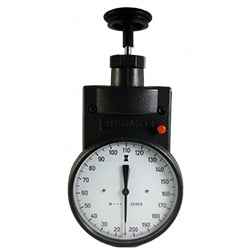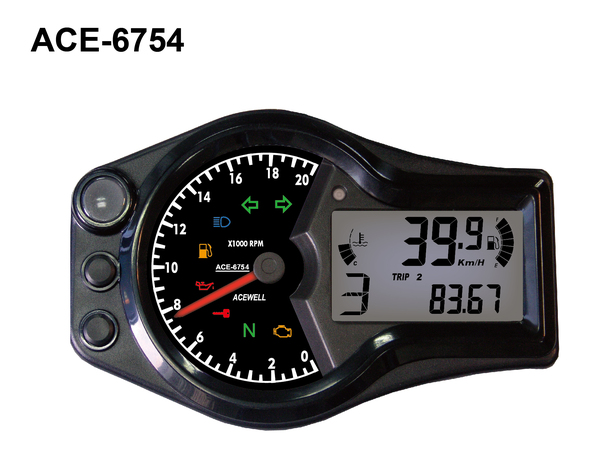Tachometer Basics: Everything You Need to Know for Accurate Readings
Tachometer Basics: Everything You Need to Know for Accurate Readings
Blog Article
The Relevance of a Tachometer in Monitoring Engine Rate and Performance in Automotive Applications
In the world of auto design, the tachometer stands as a pivotal instrument in the motorist's arsenal, offering a straight home window into the internal functions of a lorry's engine. Beyond its function as a simple gauge of transformations per minute (RPM), the tachometer serves as a critical device for fanatics and specialists alike, supplying real-time understandings right into engine efficiency and wellness.
Relevance of Checking Engine RPM
Checking engine RPM, or changes per min, is an essential facet of auto upkeep and performance examination. Engine RPM directly correlates with the rate at which the engine's crankshaft revolves, showing exactly how promptly the engine is running - tachometer. By checking RPM, technicians can examine the health and wellness of the engine, discover potential concerns, and fine-tune efficiency. An irregular RPM reading may signify issues such as engine misfires, defective spark plugs, or concerns with the gas shipment system. Consistently high RPM analyses might indicate hostile driving routines or the need for a greater gear shift to boost fuel performance.
Furthermore, keeping track of engine RPM is crucial for performance assessment in auto racing and high-performance cars. In recap, monitoring engine RPM is not only vital for finding concerns yet additionally for enhancing engine efficiency in different vehicle applications.

Benefits of Real-Time Data
In vehicle applications, real-time information plays a crucial role in offering immediate insights into the performance and condition of the car. By constantly keeping an eye on different specifications such as engine rate, temperature, fuel usage, and much more, real-time data provides various benefits that contribute to enhanced efficiency and safety and security when driving.
Additionally, real-time information helps with performance optimization by supplying immediate responses on driving practices and engine performance. Chauffeurs can adjust their habits in real-time based on this information to accomplish better gas economy and extend the lifespan of their automobile.

Additionally, real-time data plays a crucial role in contemporary auto diagnostics, allowing professionals to rapidly detect and address malfunctions. This brings about decreased downtime, reduced upkeep costs, and eventually, boosted overall car integrity and durability (tachometer). By harnessing the power of real-time information, vehicle stakeholders can make educated decisions that favorably impact both the efficiency and durability of the vehicle
Impact on Equipment Shifts
The tachometer plays an important function in optimizing gear shifts by providing real-time engine rate information to the vehicle driver. When Web Site coming close to the redline on the tachometer, it indicates the motorist to upshift to avoid over-revving the engine and triggering potential damage.
In addition, the tachometer help in attaining smoother gear transitions, particularly in hand-operated transmissions. By checking engine rate, motorists can perform gear changes at the ideal RPM variety, reducing snagging movements and reducing wear on the transmission parts. This precision in gear adjustments not just enhances driving convenience but additionally adds to fuel efficiency.
Enhancing Gas Efficiency
Offered the important function the tachometer plays in optimizing equipment shifts for efficiency and engine health and wellness, it directly adds to optimizing fuel performance in automobile applications. By providing real-time responses on engine speed, the tachometer aids chauffeurs in keeping the most reliable RPM variety for gas economic climate. When vehicle drivers constantly monitor the tachometer and change their driving routines accordingly, they can prevent unneeded fuel usage created by over-revving or carrying the engine.
In addition, Click This Link the tachometer assists vehicle drivers identify one of the most fuel-efficient equipment to be in at any provided minute, avoiding the engine from functioning tougher than required. This is particularly important during velocity and travelling, where being in the best equipment can considerably influence fuel effectiveness. In addition, the tachometer can notify motorists to potential mechanical issues that might be adversely influencing fuel economy, such as a slipping clutch or a stopped up air filter. To conclude, the tachometer functions as an important device in boosting gas performance by promoting optimal driving practices and determining locations for enhancement in the lorry's efficiency.

Taking Full Advantage Of Engine Longevity
The tachometer's role in monitoring engine rate and efficiency contributes in guaranteeing the longevity of auto engines. By utilizing the tachometer effectively, vehicle drivers can enhance engine durability through conscious RPM administration. Consistently revving an engine too expensive can cause extreme wear and tear on essential elements, such as the pistons, valves, and bearings. In time, this can result in decreased engine efficiency and prospective breakdowns. Checking the tachometer enables vehicle drivers to remain within the recommended RPM array for their car, protecting against unneeded strain on the engine and prolonging its lifespan.

Conclusion
In verdict, the tachometer plays an essential role in checking engine speed and performance in auto applications. By offering real-time linked here information on RPM, it permits reliable gear shifts, boosted gas efficiency, and optimized engine longevity. This tool is necessary for maintaining optimum engine efficiency and ensuring the overall capability of a lorry.
Report this page